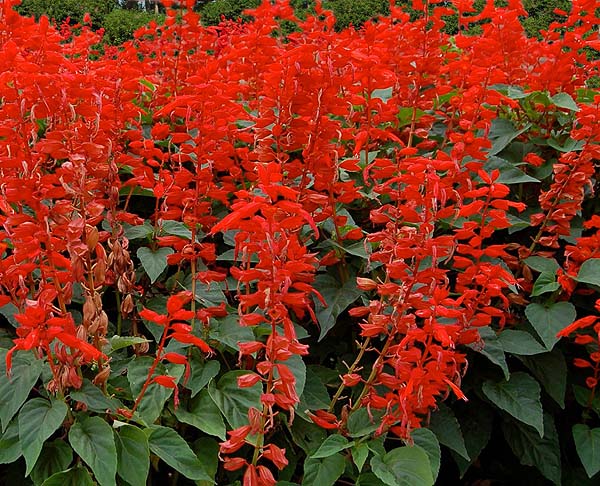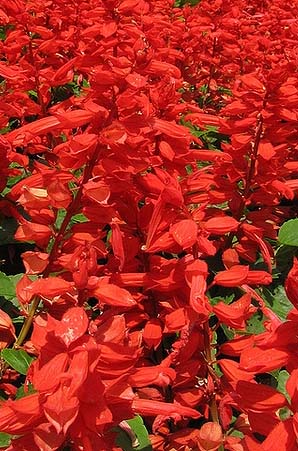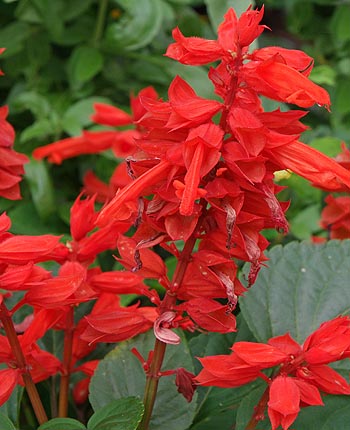Beautiful spikes of bright red flowers that continue all summer long until frost kills them. Salvia bonfire is very showy and really brightens the garden. It also attracts humming birds who are one of the few critters that can reach the nectar in the tubular flowers. Mostly grown as an annual it can act like a perennial in warmer areas (zones 8+). Easy to grow from seed and flowers within 6-8 weeks from sowing. Needs full sun for best results and a well drained soil does not like it wet. Does well in pots and makes a great accent to patios and decks. Plant close to the house so you can enjoy watching the humming birds. You will be glad you did.
Growing Scarlet Sage 'Bonfire' (Salvia splendens) from Seed.
Seeds need light to germinate so do not cover. For early displays sow seeds indoors in late winter in small individual pots or cell trays. Keep soil moist but not wet until the seeds germinate and grow. This is best done by spraying the water so the seeds do not accidently become mixed with the soil and lose light. Place in bright light, a south window or grow lights no more than 18 inches (45.72cm) from the seed tray and keep at 65-70 F (18.3-21 C) until they germinate. If in an open tray carefully remove the seedlings as they develop and pot into their own pots. Grow on until they reach at least 3 inches (7.62 cm) in height before hardening off and planting outside after all danger of frost has passed. For more details on starting seeds see our General Growing Instructions.
They are not really fussy about soil type but it needs to be well drained. they cannot tolerate wet or waterlogged soils.
They do need water and are not drought tolerant. Place in areas where they get good rainfall or supplement with watering. A soaker hose around the base of the plants is an ideal way to distribute moisture easily.
Salvias make good potted plants and can be grown on decks, patios or as accents in the garden just ensure that the pots are regularly watered. The larger the pot the bigger your plant will become so choose carefully. This is an excellent way of getting the plants close to the house windows so you can enjoy the wildlife visiting the flowers.
Red salvias are fairly heavy feeders so offering them fertilizer during the year will make your plants bigger and stronger. Adding compost to the soil before they are planted is a good start, then a liquid fertilizer once a month or in strong growing locations twice a month is ideal. Plants can become large and bushy with such treatments. They will still grow well with just soil compost if you don't have time to feed them but they will not be as large.
For most of the country this plant is grown as an annual. It will be killed by winter frosts and decimated by cold winters. Remove dead plants either in the fall or early spring.
In warmer zones (8+) they act as perennials but may looe all their leaves in winter. Before pulling out check carefully to see if roots are still alive or you could remove plants that will give you flowers next year. Mulching around the flowers roots can help it to fend of any cold (not serious cold) and help it through the winter.
In most cases new stems arise in spring but sometimes the stems will regrow leaves. However removing some stems over time can stop the plants from becoming leggy and less attractive.
Some sources suggest deadheading the plants as flowers die to help promote more flowers and keep the plants tidy. While this can be done it is not necessary plants will form many blooms over the season. if you have time to clean up your plants that's a bonus.
Ants can also be a problem as they will bite the back of the flower from outside and rob it of the nectar.
There are also reports of whitefly on red salvia but for the most part if the plants are kept health and strong this is not usually a problem. However ensure that any plants you buy, no matter what are inspected before purchase and rejected if there are any pests on them. Don't bring the problem home with you.








